Dream Homes Face the Wrecking Ball: The Sad Stories Behind These12 Once Beautiful Estates
The homes you’re about to discover were bought by such A-listers as Donald Trump, Al Capone, Rosie O’Donnell, Jayne Mansfield, and even Prince Andrew! These and other wealthy folks poured millions into building their dream homes. They created magnificent sprawling estates, with more bedrooms than even they could count. Let’s not forget about all the pools, tennis courts, and more.
Want to see them? Sorry, you’re too late. These homes were, or are slated to be, torn down. And each home has quite a story to tell. Thankfully, we have pictures, so you can catch a glimpse of these homes in their former glory.
Al Capone’s Miami Home – The South Side Gang Boss
Al Capone, the famous mafia boss, lived here until he died in 1947. The estate is massive, measuring 30,000 square feet. The grounds are lush, set in a plot of land tucked away from other homes. This location assured the mafioso’s privacy.

Source: EWM Realty International
This home will soon bite the dust unless local protests are successful. It seems that the community considers this home a local treasure, so even though the current owner wants to knock it down, that may not happen.
[NOTE: according to a recent article, this home is no longer going to be demolished]
Al Capone’s Miami Villa Hideaway
When Al Capone needed to escape rival gangs or police, he’d come to his Miami hideout, which he purchased for $40,000 in 1928. Security is tight, including a seven-foot-high wall, a gatehouse, and $200,000 in other security features.

Source: EWM Realty International
It doesn’t take much imagination or watching many movies to paint a picture of what went on in this estate. How many life-or-death decisions, how many deals, and how many lives were affected by the conversations that took place here?
Al Capone’s Miami Villa – A Look Inside
Mae Capone, Al’s widow, sold the home in 1952, but a look inside shows that many of the original features remain. Who sat in those chairs, and what did they talk about as they lounged there?

Source: EWM Realty International
Do you think the authorities didn’t know when Capone was in the house? With the security features he installed, Capone would probably have known if any cops came dangerously close to the estate. Maybe the authorities wised up and stayed away. After all, the owner was a very powerful man.
Al Capone’s Miami Villa – How Will the New House Look?
The new owner purchased Capone’s land for less than $10.8 million with a plan to build a modern-looking home in its place. The image below is what the home could look like once the demolition is done.

Source: Corcoran
Still, this may not happen as it seems the protests were successful. So, it looks like the old estate will remain a community treasure. Would you want to visit Capone’s home? Sit in his chair? Maybe see if you can find some hidden cash?
Rosie O’Donnell’s Mansion – Five Years on the Market
O’Donnell took a big hit on the sale of her home in New Jersey. After waiting for five years for a buyer, she sold it for $5.3 million. Not a bad price. However, it was $1 million less than she originally paid. Ouch.

Source: Realtor
And what’s coming after the purchase? Will there be a renovation? Nope – the new owners want to tear it down and develop new homes on the plot. Can you imagine how Rosie must feel? She lost money on the deal and now she has to live with the fact that her old dream home will be torn down.
Look at Rosie’s Entranceway!
Some famous folks live near Rosie in Saddle River, and a billionaire recently moved into the neighborhood. By the way, the home is still gorgeous inside. Apparently, no one has emptied it yet. Check out the image below – this is just the entryway.

Source: Realtor
When the new owners tear down the estate, they will be giving up a mansion with an amazing backyard. Rosie fitted her yard to the tastes of her kids, her friends, and her family, with a pool, a Jacuzzi, and a waterfall.
Inside Rosie O’Donnell’s Mansion
The house has six bedrooms and nine (nine!) bathrooms. Look at this peaceful retreat and try to imagine a wrecking ball destroying it. Indeed, for some of us, our entire apartment could fit into this bedroom.

Source: Realtor
With over 9,000 square feet and all those bathrooms and bedrooms, not to mention many renovations and redecorations over the years, a lot of work has gone into this place. Sadly, it will soon be nothing but rubble.
Rosie’s Guesthouse!
Some of us wouldn’t mind living in this guesthouse permanently. It’s got two bedrooms, a kitchen, two bathrooms, and a laundry room. Is it lavish? Yes. However, this guesthouse is also a warm and welcoming space for any loved ones who visit.

Source: Realtor
However, the construction crew will be knocking this down as well. On a positive note, 20% of the properties built on this plot will be used for affordable housing. So that’s a happy ending; maybe Rosie’s satisfied with that.
Donald Trump's Palm Beach Show Stopper
In 2004, Trump spent a mere $41 million to purchase this “compound.” We’re assuming a compound is more expansive than an estate but smaller than a state. Is that right? Either way, Don got it at a bankruptcy auction. Can you imagine Donald Trump needing to buy at an auction?

Source: Davidoff Studios/Getty
Upon purchasing the estate, a reporter asked him why he needed another huge Florida home. His humble remark was: “It will be the second-greatest house in America.” The first being his Mar-a-Lago home, of course.
Donald Trump Renovates
The compound is about 60,000 square feet (the average mansion is approximately 8,000 square feet, so you do the math). That’s just about the size of a football field. And apparently, it was not designed to Trump’s taste.

Source: Davidoff Studios/Getty
After the purchase, the Trumps spent about $25 million renovating the compound. In his own words, Donald Trump said they only “cleaned it up a little.” From the looks of it, the reno included adding the signature Trump gold accents.
Trump’s Compound “Extras”
The compound included a ballroom, an art gallery, a 40-car garage, and diamond and gold fixtures. However, the lavish design, part of Trump’s $25 million renovation, was doomed from the start.
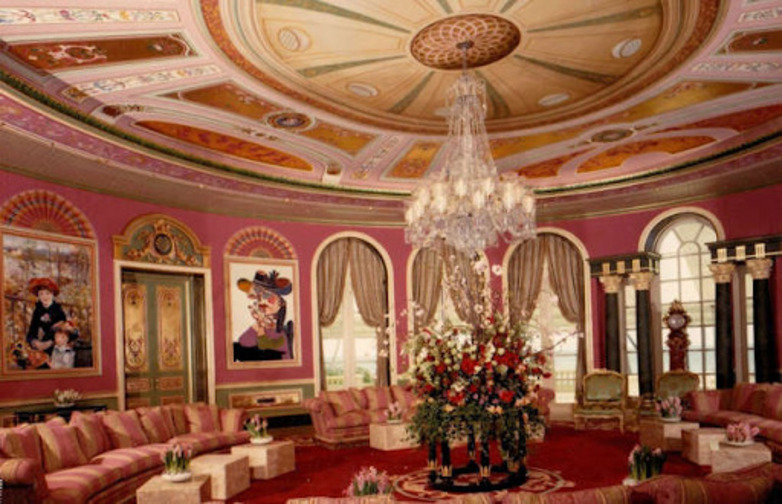
Source: Davidoff Studios/Getty
Why was it doomed? The short answer is mold. The home developed such a severe mold problem that it forced the Trumps to sell it in 2008. A Russian billionaire bought it for $95 million, more than double what Trump paid. Did this billionaire not care about the mold? Go figure.
Selling Trump’s Compound
When someone like Donald Trump sells a home to a Russian billionaire for more than double the purchase price, the authorities become curious. An investigation into the purchase led to accusations of money laundering.

Source: Google Earth
However, after the investigation, Trump was not formally accused. In the end, the mold killed any plans to develop the property further, and the home was demolished in 2016. Not to worry – the Russian oligarch came out ahead somehow. At least we can all rest easy in knowing it worked out well for both of these obscenely wealthy individuals!
The Pink Palace of Jayne Mansfield, California
Originally a white mansion, the famous Pink Palace on Sunset Boulevard in Los Angeles was purchased by megastar Jayne Mansfield in 1957 for around US$700,000 in today’s money. She bought it just before she married former Mr. Universe, Mickey Hargitay.

Source: Paul Harris/Getty
Mansfield’s signature pink color was immediately applied to the outside of the home, and pretty soon, it was splashed everywhere inside and outside the home. There were pink plush carpets, pink walls, and pink furniture. At least it was easy to find.
Inside the Pink Palace
Mansfield re-decorated the 40-room home and even added a white and gold Steinway piano and a cupid fountain that flowed with pink champagne. Her husband built the heart-shaped pool, which was, you guessed it, pink.

Source: Bettmann/Getty
In the picture, you can see Jayne (without her signature blonde hair) posing beside her gorgeous pool, designed and built by her husband. Hargitay was a former Mr. Universe and a well-known Hungarian-American actor. One of the couple’s three children is Mariska Hargitay, the Law and Order actor.
Who Else Lived in the Pink Palace? Did They Un-Pink It?
Mansfield died in a car crash in 1967, but her home was not empty for long. Iconic as it was, many Hollywood stars wanted to live in it. Below is Englebert Humperdinck, who enjoyed the lavish decor while he lived in the home.

Source: Paul Harris/Getty
Aside from Humperdinck, Ringo Starr and Cass Elliott were owners at one time. As soon as Ringo moved in, he repainted the outside of the home white – several times. However, somehow, the pink still shone through, as if Mansfield still had control over it in the afterlife.
The Pink Palace Meets Its Demise
Engelbert Humperdinck lived in the palace for 26 years. However, in 2002, he sold it to his neighbor, a mortgage tycoon, for $30 million. The new owner demolished the house, and conservationists were horrified to lose this symbol of one of Hollywood’s great stars.

Source: Paul Harris/Getty
The new owner created his estate on the land, now called the Arnall Owlwood Estate. It is no longer pink. We can sympathize with the angry locals who wanted Mansfield’s mansion preserved. After all, it’s not every day you see a pink palace on your morning walk!
Prince Andrew and Fergie’s Little Place in Berkshire, UK
Now here’s a wedding gift – the Duke and Duchess of York, Prince Andrew and Princess Fergie, received a 665-acre piece of land from Queen Elizabeth when they married in 1986. Of course, many people have generous in-laws, but this is epic.

Source: Tony Harris/PA Archive/PA Images
In 1987 this 12-bedroom mansion was built on this expansive plot of land. Inside were several reception rooms (one often needs more than one), and outside, there were stables (that’s also plural) and a swimming pool. Of course, Prince Andrew didn’t remain in good favor (to put it mildly), and this impacted all his properties.
The End for Andrew and Fergie’s Mansion
The mansion was solid, but the marriage fell apart. The couple divorced in 1996 but still lived together with their children for a few years. Andrew and Fergie were determined to co-parent their daughters and live as a family, although not married.

Source: Dee Earley/Wikimedia Commons [CC BY-SA 3.0]
In 2007, Prince Andrew sold the home to a Kazakhstani investor for $19 million. It’s a little like getting cash back for that sweater you got from Grandma for your birthday. One doesn’t imagine that the Prince returned the proceeds to the Queen.
More Than the Marriage Crumbled
In the mid-2000s, Andrew’s scandalous relationships began to emerge, and it was also discovered that Fergie had been involved in several unsavory situations. It was time to move out of the home and sell it.

Source: Sunninghill Park/Facebook
The new owner of the estate, a billionaire oligarch, abandoned the mansion, which deteriorated and was reduced to rubble in 2016. Things got so bad that the local city council threatened to confiscate the property. The owner then demolished it and replaced the home with a larger one. Can you believe it?
A Drug Lord’s Beach House in Florida
Unquestionably the most famous and notorious drug lord of all time, Pablo Escobar, a man worth up to $30 billion by the early 1990s, owned this pink beach house in Miami. Jayne Mansfield would have approved.

Source: Diego Urdaneta/AFP/Getty
Escobar thrived by avoiding the scrutiny and capture of the federal and local authorities and escaping capture by his enemies. For that, he needed several dream homes around the world. With his fortune, it was easy for him to skip from one to another to avoid confrontation.
Easy Come, Easy Go?
Escobar paid $765,500 for the home in 1980 and most likely used it as a cocaine shipment safe house. But it wasn’t his for long because, in 1987, US authorities seized it. They also took hold of nearly $20 million of the Medellín Cartel’s Florida real estate assets. Ouch!

Source: One Sotheby’s Realty
Reports suggest that during his heyday, the narco-terrorist was responsible for countless Colombian deaths and 80% of the cocaine smuggled into the United States. Known as “El Patron” (the Boss), he brought in more than $270 million in weekly profits. Yes, that’s a weekly figure!
Easy Come, Not so Easy Go
After he surrendered in 1991, he designed and built his jail cell. Comfy as it was, he escaped and was on the run until he was finally killed in December 1993 in his hometown of Medellin, Colombia. Escobar certainly lived a risky but exciting life!

Source: One Sotheby’s Realty
The Miami property didn’t fare so well either – it was damaged by fire and stayed in poor shape until it was bought in 2014 by Christian de Berdouaré, who had a plan before demolishing it.
Search and Destroy
The new owner of the Escobar home assumed that the drug kingpin must have squirreled away significant sums of cash throughout the house. After all, it must be awfully difficult to hide the almost $30 billion he earned each year.

Source: Manny Hernandez / Getty
So Berdouaré ordered a thorough search of the home. Workers did discover a hidden safe, but the public never found out what was inside. A new home was never built, and Berdouaré eventually listed the property for sale. Nothing seemed to come of it, so the mansion remained empty, cashless, and pink.
Alva and William Vanderbilt’s Chateau, New York, USA
By 1877, William Vanderbilt was known as “The Commodore.” He was also famed for being the world’s richest man. He and his wife Alva decided to build a magnificent chateau on Fifth Avenue and 57th Street to help launch their entry into New York society.

Source: Falk, B. J./Wikimedia Commons [Public domain]
The chateau impressed the neighbors, becoming one of the most lavish mansions of the “Gilded Age.” The plan worked, and the couple was accepted with open arms into the A-Listers league. They achieved this at a time when new money was looked down upon, so kudos to them.
The Vanderbilts’ “Little” Home
The couple called their home a mini-chateau, although, to most people, there was nothing “mini” about it. Indeed, the house was so magnificent that it received praise in architectural circles. This hype must have made Alva very proud.

Source: Cornell University Library/Wikimedia Commons [Public domain]
The furnishings were of the highest quality, which Alva chose carefully – she wanted the right people to talk about her home. The interiors were decorated from trips to Europe, with items from both antique shops and from “pillaging the ancient homes of impoverished nobility.”
Just the Place for Entertaining the Neighbors
In one of many odd decorating decisions, a bureau once owned by Marie Antoinette found its way into the mansion. It was only the best for the Vanderbilts. For example, this salon was designed by a French interior decorator. Perhaps that explains the desire for Marie Antoinette’s bureau.
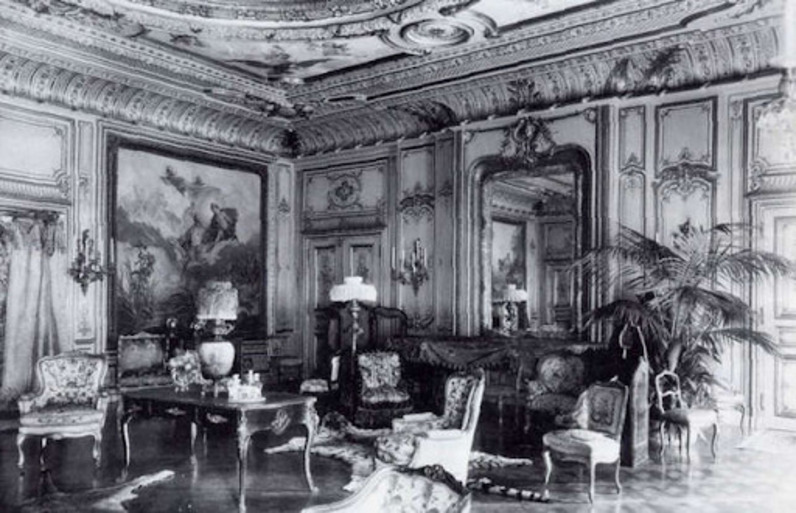
Source: Architectural Record/Wikimedia Commons [Public domain]
After Alva completed the decorating, her societal position was secured when she threw a fancy dress ball for 1,200 people – everyone was talking. Alva spent a fortune on the party, which would equate to over $7 million today. The society columns labeled the event a triumph.
Another Crumbling Marriage and Crumbling Home
The Vanderbilts divorced in 1895 and subsequently put their home on the market. Oddly enough, it remained vacant for over twenty years. During this time, the magnificent structure lay empty and decaying.

Source: Bettmann/Getty
It was finally bought and demolished to make way for an office tower. Seeing the decay inside the once-magnificent home tells the tale of a bygone era – the Gilded Age was over, and the business of business occupied midtown Manhattan. There’s something tragic about this, especially for lovers of great architecture.
Pottie and Bertha Palmer’s Mansion, Chicago, Illinois
A home that would cost $30,000,000 today (and was built for $1 million in the 1880s) was commissioned by Pottie and Bertha Palmer on what was to become Chicago’s super-elite Gold Coast. Palmer was one of the primary rebuilders of Chicago after the Great Fire of 1871.

Source: Unknown author/Wikimedia Commons [Public domain]
The home was enormous, overpowering the famous Lake Shore Drive neighborhood. At $1 million, it went way, way over budget. After its construction, other wealthy families began building in the area.
Inside the Themed Rooms of the Palmer Mansion
Imagine your home with themed rooms. The Palmers did more than just imagine this concept. In their odd and spectacular mansion, the rooms were decorated to portray different international cultures. These themed spaces took visitors on a voyage through Italian style, Louis XVI vibes, Renaissance decor, and more.
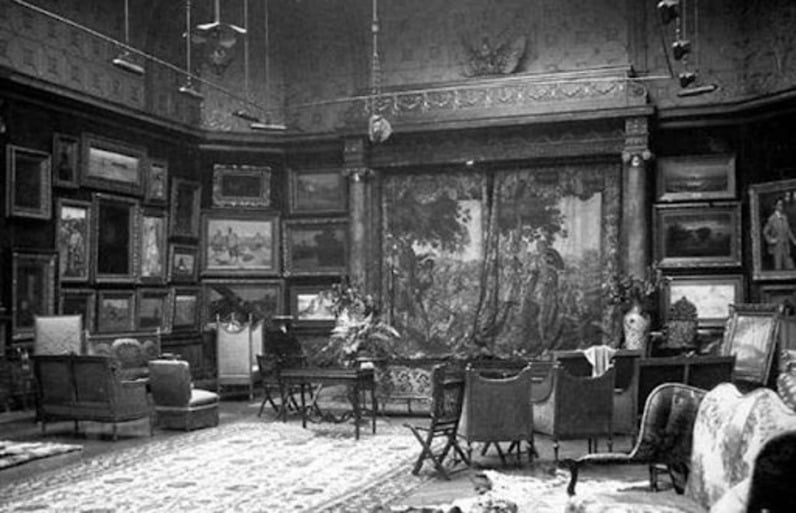
Source: Wikimedia Commons [Public domain]
Visitors gasped at the magnificence of the themed rooms, overwhelmed by the effort taken to procure pieces from each culture. This was the home that everyone talked about, and locals admired the Palmers for their unique taste.
The Palmer Mansion – A Little Art Collection
Bertha Palmer was a bit of a renegade. Instead of following the current art trends in America, she sought out new works during her trips abroad. She was an avid collector of Renoir, Monet, and Degas.

Source: Institutional Archives/Art Institute of Chicago
What does one do with so much art? Why, one builds a gallery addition to one’s home, of course! And this is what Bertha Palmer did. The wealthy woman added a 900-foot gallery to show off her collection properly. Was it lavish? Yes. Was it worthwhile? If you were to ask Bertha, she’d answer with a resounding “of course, darling!”
At Least the Art is Safe
Ah, family drama. Don’t you just love it? The Palmer mansion was sold in 1928, but the extended family was not happy with the sale. They bought it back in 1934, then sold it again in 1945.

Source: Library of Congress [Public domain]
The buyer demolished it to make way for an apartment building. It is hard to imagine a wrecking ball slamming into this structure and leveling it to the ground. Are you worried about the art? Thankfully, most of it was donated to the Chicago Institute of Art and various other institutes.
Fans of Downton Abbey – Meet The Deepdene of Surrey, UK
Downton Abbey recalls the era in English history when stately mansions became too expensive to maintain. In fact, since 1900, almost 2,000 of England’s finest country homes have been demolished.

Source: Dorking Museum & Heritage Centre/English Heritage
These historical facts provide the foundation for the story of The Deepdene. Like other wealthy families of the era, when faced with death duties and taxes, the family could not afford to keep the staff, equipment, and supplies needed to run such a vast estate. So, they were left with an undesirable decision on their hands.
An Honorable Mention in the Domesday Book!
This estate was constructed sometime in the 1760s and bought by a wealthy man in 1807 who enlarged it. As a result, it was deemed worthy enough to be listed in The Domesday Book (which listed all significant land holdings in England).

Source: Dorking Museum & Heritage Centre/English Heritage
The new owner was Thomas Hope, who at the time was one of England’s wealthiest men. His enlargement plan included a library, gallery, and an orangery. Yes, an orangery. And yes, you guessed it – that’s a building where orange trees can grow, even in the winter.
Deepdene’s New Look
Thomas Hope, the new owner, liked changing things up. In an odd move, he removed original ancient statues and replaced them with reproductions. One wonders what would motivate someone to give up priceless originals and replace them with fakes.

Source: The Print Collector/Print Collector/Getty
Hope got the reno bug again in 1836 and 1841, this time wanting the home to resemble a Roman villa. By the end of the 19th century, he had leased the estate to Winston Churchill’s aunt, Lily the Duchess of Marlborough.
Deepdene: From the Domesday Book to This?
The home was turned into a fancy hotel in the 1920s, which operated between the two World Wars. After that, it served as a set of government offices during World War II. It now has the drab and dreary appearance you can see in the image below.

Source: Ian Capper [CC BY-SA 2.0]
If you’re like us, you probably heaved a big sigh when you saw how the glorious estate devolved. This ugly construction now occupies that plot of land – a depressing 1960s-style office building. We suppose this is progress.
Trentham Hall – Staffordshire, UK
Now, this is a grand home! And it dates back to the Middle Ages. In 1833, it was reconstructed by the same man who designed the Palace of Westminster. It was eventually demolished, but not for the usual reasons.
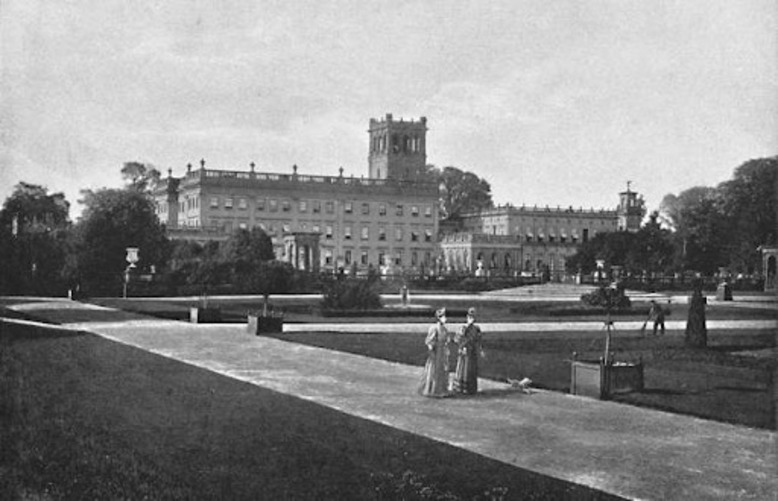
Source: The Print Collector/Getty
Someone could easily get lost in this mammoth home. How many bathrooms and bedrooms do you think there were? How many reception rooms and ballrooms? We have a feeling we’d lose count if we tried to make a tally while wandering those vast halls.
Trentham Hall – The Shah Was Impressed
When the Shah of Persia visited this home with the future King Edward VII in 1873, he was so impressed with the furnishings and grandeur that he suggested that only the King deserved an estate so grand and that perhaps the current owner should be “done away with,” to put it mildly.

Source: Courtesy Staffordshire Archives and Heritage [Public domain]
With all the grandeur, renovations, and decoration, however, there was one big problem in Trentham Hall – pollution from the River Trent. In short, the house stunk. Is a smelly abode really fit for a king?
Trentham Hall vs. The River Trent
Unfortunately, Trentham Hall was built near the River Trent. And even more unfortunately, the River Trent was a source of sewage and stench. Little by little, the sewage coming down the river caused horrific odors to accumulate in the stately home.

Source: Courtesy Staffordshire Archives and Heritage [Public domain]
The authorities did not seem able to control the pollution-contaminated River Trent. It made Trentham Hall uninhabitable, not just because of the stench but also because of the health hazards. Without a willing buyer, it was demolished in 1912.
Trentham Hall Ruins and Gardens
Pictured below are the few parts of the home that still stand. The square tower and grand entrance are visitor sites if you like that sort of thing. We’re sure there are plenty of beautifully overgrown corners to explore.

Source: Mike Peel/Wikimedia Commons [CC BY-SA 4.0]
Happily, the gardens have been reborn and are said to be glorious. It’s unclear whether the River Trent stench and pollution remain – you’d have to go and find out for yourself. If you visit this beautiful ruin, please do let us know!
Chateau Miranda, Celles, Belgium
A little French Revolution history here – the owners of this chateau, an aristocratic family called Liedekerke-Beaufort, had to relinquish their original home during the Revolution and relocate to Celles. We can’t imagine how it must have felt to leave this beauty behind.
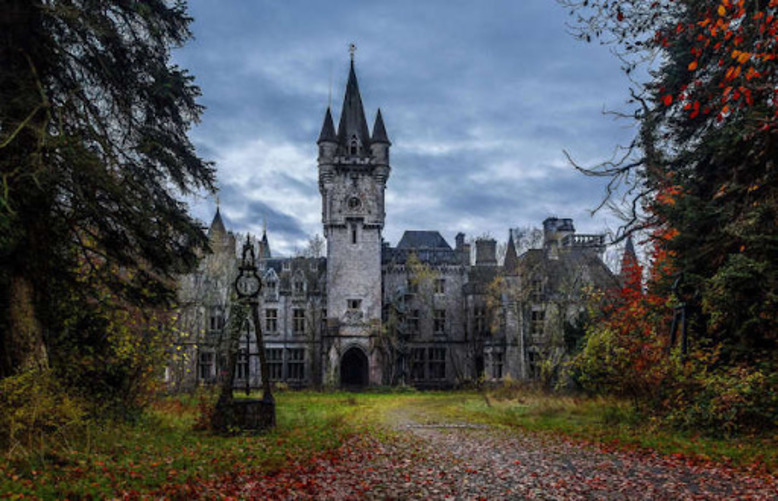
Source: rphstock
In Celles, English architect Edward Milner built this fabulous home. It looks like Cinderella’s Castle, right? Anyway, it’s a little sad that the family had to give up their original home, but hopefully, their new one lifted their spirits a bit.
Chateau Miranda – More Troubles for the Family
World War II came after the revolution, and once again, the family had to give up their home under pressure from invading forces. The home was taken over by the Nazis during the war, as were many grand homes in many countries.

Source: foam/Flickr [CC BY-ND 2.0]
After the war, probably due to the sadly huge number of children who became orphans during those years, the house became an orphanage and holiday camp. After that, it was used as a school until 1991. These are both excellent uses for a home that has seen so much loss.
Chateau Miranda - A Tale of Fire and Storms
Bad fortune seemed to be in this house’s future. After being abandoned in 1991, it stood empty, with no one interested in purchasing it. Then a fire in 1995 and a freak torrential storm in 2006 destroyed much of what was left.

Source: vander_didier/Flickr [CC BY-ND 2.0]
In 2016, a local developer decided to move the structure to Spain. He planned to dismantle the building and move it piece by piece to the new location. This was an interesting plan, to say the least, and very ambitious.
Chateau Miranda – It Gets Worse
For such an opulent property, this estate experienced more than its fair share of bad luck. Unfortunately, the new owner became ill in 2017 and pulled out of the deal, leaving the building empty.

Source: adoptunchateau/Facebook
After being the new home for a displaced family, an office building for the Nazis, an orphanage, a school, and potentially being moved to Spain, all hope was lost. With the new buyer’s serious illness, the decision was made to demolish the chateau in late 2017.
Winship Mansion – Massachusetts, USA
Eleven bedrooms and eight bathrooms feature in this grand house constructed for Charles Winship. Built in the early 20th century, it quickly earned a reputation as one of the most magnificent estates for miles around. It had huge reception rooms and a grand swimming pool.

Source: Unknown (Deceased)/Wikimedia Commons [Public domain]
Charles Winship was famous in the area, being the owner of Harvard Knitting Mills – the largest employer in Wakefield during the first third of the twentieth century. One wonders what his employees thought of this mansion.
Winship Mansion – Home to Convent to Home
Inside the home, visitors were struck by the lavish interior with grand furnishings, expensive carpets, dramatic light fixtures, and hand-carved wooden staircases. Winship spared no expense on making the home exquisite.

Source: Murphy 1827/Wikimedia Commons [CC BY-SA 4.0]
Winship died in 1946, and the glorious estate was put to other uses. It was utilized as a convent until 1978 and then sold once again to become a private home. Of course, it wouldn’t feature on this list if it wasn’t doomed to destruction. Let’s see what happened, shall we?
Winship Mansion – Fire, Foreclosure, and Vandalism
In a sad turn of events, a fire damaged the home in 2005, and it was then lost to foreclosure in 2007. It’s sad to see such a magnificent structure, with equally dramatic furnishings, ruined and empty.

Source: Murphy 1827/Wikimedia Commons [CC BY-SA 4.0]
Since the owner was unable to sell it, the structure was left vacant. This was the perfect opportunity for vandals to get in and ruin the fixtures and furnishings. What a sad ending for this glorious home, built lovingly by a self-made man.
Winship Mansion – On the National Register but Beyond Repair
A local realtor purchased the home in 2019 for $585,900. That price is a good one considering the state the property was in at the time. Adding to its value, the home was listed on the National Register of Historic Places.

Source: Mark Sardella/Wikimedia Commons [CC BY-SA 4.0]
However, neglect and deliberate damage had done their worst, and by the time of the sale, the home was considered beyond repair and unliveable. Bulldozers rumbled onto the property in July 2020 to tear it down. Two residences are now slated to be built on the lot.
